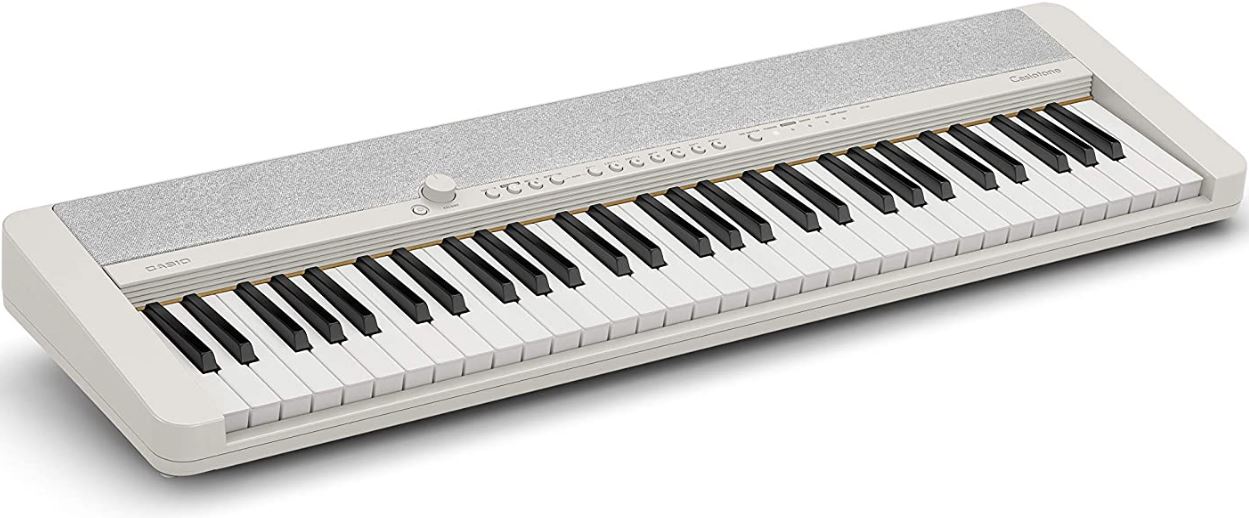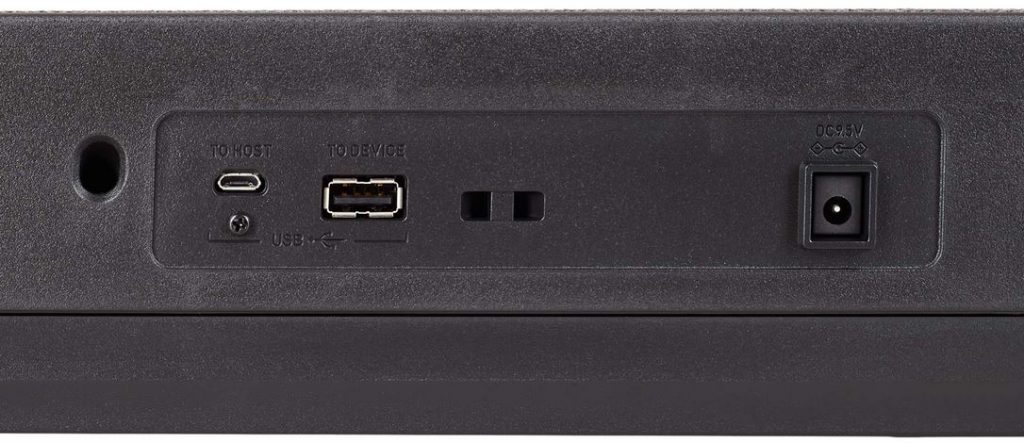Casio, a renowned brand in the world of musical instruments, has been consistently delivering high-quality keyboards that cater to the needs of musicians across various genres and skill levels. The CT-S series keyboards from Casio has gained popularity among beginners as well as experienced players for its sleek design, portability, and exceptional performance. I am a bit late with the review: it has been 2 years since CT-S1 came out and I have long wanted to see and test it but didn’t have a chance to do it until now. But better late than never, so my CT-S1 review is below.
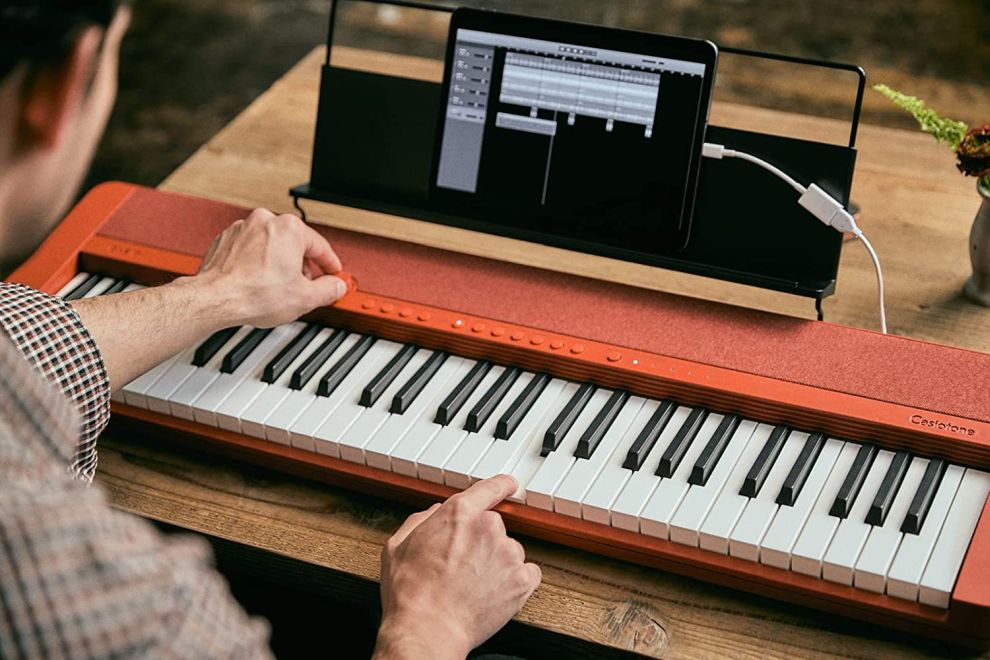
Table of Contents
Casio CT-S1 Main Specs
Design/Portability
The Casio CT-S1 boasts a sleek and contemporary design that catches the eye at first glance. We can surely notice that Casio paid attention to details. The speakers cover looks high quality and softens the look of hard plastic. A strip of felt along the entire keyboard prevents the dust from getting into the instrument. All this and even the Casiotone logo engraved in plastic shows that Casio pays very much attention to details in this fairly budget keyboard.
As this is mostly a piano, the interface is very simple and intuitive without any display and hundreds of buttons that could draw your attention. It allows you to start playing write out of the box without opening the manual.
Its slim profile and lightweight construction (it weighs only 9.9 lbs/4.5 kg) make it extremely portable, allowing musicians to take their music wherever they go. The keyboard can also be battery powered, though they run out rather quickly. For maximum portability, the Casio CT-S1 features a dedicated handle and belt mounts for guitar-compatible strap. The latter allow you also to perform with the keyboard on your shoulder and look like a rocker 😉
The keyboard comes in 3 different colors: Black (CT-S1BK), White (CT-S1WE) and Red (CT-S1RD). As per me white is just beautiful, black is for classic strict design lovers, and red – for those who want to stand out.
Keyboard
One of the standout features of the CT-S1 is its responsive and dynamic keyboard. With its 61 full-size semi-weighted touch-sensitive keys (similar to Korg B2N, Yamaha NP32), the CT-S1 allows for expressive playing, enabling you to explore a wide range of musical styles with precision and accuracy.
Though the keys are not fully weighted, but this is kind of intermediate option that could suit both beginners and advanced piano players. There are 4 levels of touch sensitivity depending on playing style. I liked that the keys are slightly textured, fingers don’t slip on them more than necessary.
Voices, Sound Quality, Speakers
Although the number of voices included is not as impressive as in other Casiotone beginner keyboards, the CT-S1 delivers only the most necessary and popular voices to enhance your musical creations. The Casio’s AiX sound engine is used to generate 61 built-in tones, including acoustic pianos, electric pianos, strings, organs, and more, so you have a rich palette of sounds at your fingertips. You can choose the most played voices by the 7 category buttons on the panel (Piano, E. Piano 1 and 2, Organ, Keyboard, Synth and Others) and use the Tone Variation button to select additional 3 voices variations from memory. For vintage lovers Casio has even included some voices from the very first 1990s Casiotone keyboards.
The sound quality is exceptional, with authentic and realistic tones that bring your music to life. The two 2.5W integrated speakers provide clear and balanced sound output, ensuring an enjoyable listening experience for both practice sessions and performances even on the highest volume. And the Surround button adds a “surround” effect to the tones, making your performance even more spacious (*it applies only to the internal speakers).
As there is no auto-accompaniment in CT-S1, the 64 polyphony notes are quite enough for the keyboard and you will hardly exceed the limit.
There are also number of pre-configured Effects and Master EQ curves, though Effects can not be modified and are tied to the built-in voices.
Additional Features, Educational Features
In addition to its excellent sound capabilities, the CT-S1 offers a host of additional features that enhance your playing and learning experience. There is no lesson mode in CT-S1, however there are some other features which may be useful for learning.
Casio CT-S1 has built-in metronome which is great for piano practice. Keyboard split feature allows to split keyboard into 2 parts to play two different instruments. And layering allows to play 2 voices (with adjustable volume) on the keyboard simultaneously. Another useful feature is that the sustain pedal can be configured to affect the sound of only one of the two layered voices. Note that both Split and Layer features are missing in previous Casiotone models – CT-S200 and CT-S300 (see my review of the best keyboards under $300)
As I’ve already said the CT-S1 has 61 keys, which is probably a bit small for advanced pianists, so of course there is an octave shift function that allows you to expand the sound up or down if the available sound range seems insufficient to you.
The CT-S1 inherited a very useful “My Setup” feature from existing Casiotones, which allows you to save your configured sound settings and quicky restore them right after you turn on the keyboard.
The built-in recorder allows you to record your performance with a simple one-track recorder. Although this is not a full featured multitrack sequencer as in Yamaha PSR-E473, but remember that this is still a piano (with extended number of voices), not an arranger keyboard. If you like you can use your favorite DAW application to record music. It is also compatible with the Casio’s Chordana app.
CT-S1 has a useful feature to remove voice from the track which you stream on it (both by Bluetooth or Aux input – see connectivity options below).
Connectivity Options
The CT-S1 is equipped with various connectivity options, allowing you to connect to external devices and expand your musical possibilities. The USB MIDI port enables seamless integration with computers and mobile devices for music production and recording. In addition to the usual wired connection via USB interface, you can additionally get an optional Bluetooth USB dongle for CT-S1 and connect wirelessly to your smartphone or your computer DAW application, or stream music from your device to Casio’s speakers as a backing track.
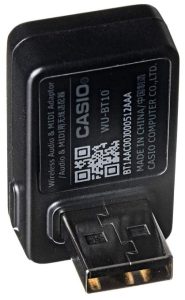
Although the price of the adapter is quite high, it certainly adds convenience and modernity to your piano. But the Audio In port is still available to connect your sound source by cable and play along with your songs the old way.
One thing that disappointed me is that CT-S1 lacks ¼ Line Outputs, but the Headphone Stereo Mini-jack can be used both to practice silently without disturbing others or to connect to the external amplifier.
Model Variations (Colors)
Casio understands the importance of personal style, and the CT-S1 offers a variety of color options to suit individual preferences. From classic black to vibrant red, you can choose a color that reflects your personality and adds a touch of elegance to your musical setup. So there 3 models available:
Of course it’s a matter of taste but I liked red the most. It looks non-standard and will emphasize your individuality.
CT-S1 vs CT-S200 vs CT-S300
Compared to the Casiotones that existed at the time CT-S1 was first introduced (CT-S200 and CT-S300), the CT-S1 obviously wins in design. This is a more like a “serious” instrument. It doesn’t have hundreds of tones but has only the most required voices (though with multiple variations of each voice). There is no auto accompaniment in CT-S1, but it has Split/Layer functionality, metronome, and a very simple 1-track recorder which you can use for practicing. CT-S1 weighs a couple of pounds more, but is still very portable.
I would not buy the CT-S200, because its keys are not touch sensitive, this keyboard is only for the very beginners.
So for me the choice would be between the CT-S300 and CT-S1. I prefer CT-S1 because it is more serious instrument, has better exterior (you can choose between 3 colors, while CT-S300 comes only in black), unique quality tones, 64 note polyphony, split/layering for live performances. But if you want to “play” with all the bells and whistles which CT-S300 has (such as Dance Music Mode) – this would still be a nice choice.
CT-S1 vs CT-S400
Later in 2021 Casio introduced the new CT-S400, an upgrade to the CT-S300, with vastly improved sounds, new features and fresh design. I can say that the CT-S400 takes the best both from its predecessor and from the CT-S1 making it some sort of improved combination of these models. It has a very useful LCD display (you won’t be able to easily control the increased number of features without it), built-in 200 improved auto accompaniment styles, pitch bend wheel, 6-track recorder. The connection set, key action and speaker system are taken from the CT-S1.
The exclusion is number of polyphony notes – CT-S1 has 64 and CT-S400 only 48 notes (same as CT-S200 and CT-S300), which can be limiting for such a keyboard especially when playing with auto-accompaniment or playing along with recordered songs which also take part of the polyphony.
As per the tones itself, the tones in CT-S1 are uniquely designed specifically for this keyboard, while the tones in CT-S400 are tones used in other Casio keyboards as well though some of them have the same name.
To summarize, you can’t actually compare the CT-S400 and CT-S1 because these are very different keyboards, even though they are about the same price. The CT-S1 is mostly for piano players who wants to play piano/organ or other instruments with unique tones solo or in a band. It is suitable for beginners who do not want to be distracted by unnecessary features such as hundreds of voices, auto accompaniment, effects, sequencer, and who just want to start playing.
The CT-S400, on the contrary, is suitable for those who want to get the most out of their keyboard, play with auto accompaniment, record using the built-in recorder, edit sounds and everything else.
So choose your way and decide for yourself which device suits you best!
Competitors from Other Brands
While the CT-S1 shines in its own right, it’s worth mentioning a few notable competitors from other brands.
CT-S1 vs Yamaha PSR-E373
At about the same cost, the Yamaha PSR-E373 is a completely different instrument. In terms of functionality PSR-E373 is better to compare with the Casio CT-S300 than with the CT-S1. PSR-E373 is a beginner synthesizer with lots of “bells and whistles” including hundreds of tones and styles, effects, built-in lesson mode and song recorder. “Super Articulation Lite” voices also add points to it. Therefore, everything that I wrote above when comparing with the CT-S300 is also true for the Yamaha PSR-E373. In my opinion Casio wins some unique tones especially vintage keyboards, and in general looks more expensive than it costs. I also like CT-S1 keyboard more pleasant to the touch, and the key action is more like semi-weighted, than the light keys in Yamaha.
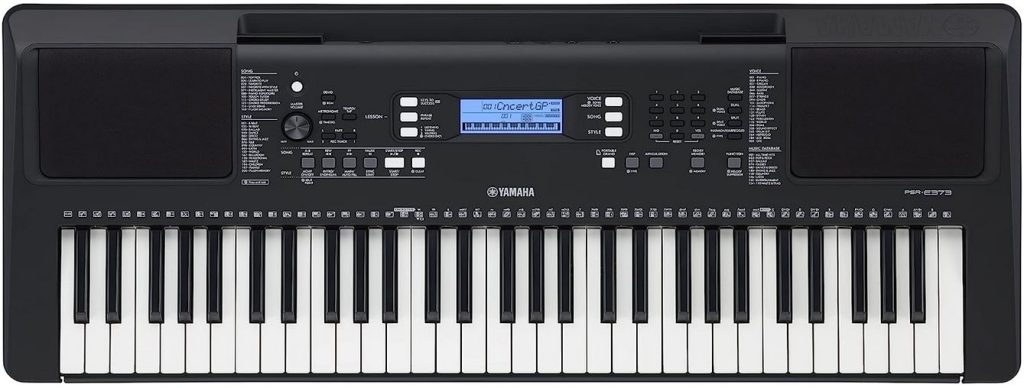
But if you are not sure about your music plans and maybe you are interested in experimenting with sounds, creating music, playing “with an orchestra”, etc. then Yamaha PSR-E373 gives you a lot more options. Check PSR-E373 price on Amazon here.
CT-S1 vs Roland GO:PIANO
GO:PIANO61 (GO-61P) is a worthy Casio competitor from Roland. This is a digital piano with non-weighted keys, similar functionality, connectivity options (including the Bluetooth connectivity) and speaker system. Here are some benefits and drawbacks of GO:PIANO compared to CT-S1.
GO:PIANO benefits vs CT-S1:
- 128 polyphony voices (64 polyphony voices in CT-S1)
- Very light weight (only 3.9 kg vs CT-S1’s 4.5 kg)
- Is available in 88 keys modification
- Built-in Bluetooth functionality
- Roland App can be used to remotely control the device, as well as playing backing Rhythms and display music notation for the onboard songs
GO:PIANO drawbacks compared to CT-S1:
- Only 40 tones (vs 61 in CT-S1)
- No split/layer functions
- Control buttons are not physical buttons, but a touch-sensitive areas. CT-S1’s buttons are physical made of plastic and are nicer to the touch
- No USB-Audio interface (only MIDI)
- Keys are too “plastic” and thin to the touch
To sum up, GO:PIANO by Roland should be definitely in your list when choosing a compact digital piano. It is a great sounding instrument, but it has some drawbacks compared to Casio CT-S1 and might probably make me opt for the latter. So CT-S1 wins in my opinion.
I should note here that there is also a 88-key version of GO:PIANO available (GO-88P). But it has a very limited functionality even compared to 61-key version of itself. So I would consider buying it only if piano is the only instrument you are interested in. Check Roland GO:PIANO61 price on Amazon here.
CT-S1 vs Yamaha NP12/NP32
One of the serious CT-S1 competitors in the same price range is Yamaha NP12. This is a portable digital piano with 61 keys non-weighted touch-sensitive keyboard, and it has a 76-key modification (NP32) with Graded Soft Touch keyboard (bass keys are heavier than the treble keys, which is a little more close to a real piano). Here are the drawbacks and the advantages of NP12 compared to CT-S1.
Yamaha NP12 Drawbacks
- Only 10 voices (vs 61 voices in CT-S1)
- No USB-Audio interface, only USB-Midi
- No Bluetooth connectivity
- No AUX input
Yamaha NP12/NP32 Advantages
- Good battery life
- Half-damper control with optional FC3A pedal
- 76-key version with Graded Soft Touch keyboard is available
- High quality music rest
Yamaha NP12 and Casio CT-S1 are close by functionality, but Yamaha has a limited number of voices and very limited connectivity options compared to Casio, however has a very good battery life and 76-key version. Casio on the other hand has a lot more voices, bluetooth (optional) and AUX input, USB-Audio, more premium exterior (and 3 colors to choose from) and easy interface. Personally for me Casio CT-S1 is the winner between these two, but if number of keys is determinative for you then Yamaha NP32 is the one you need. Check NP12/32 price on Amazon here.
As always I advise to play and listen to each keyboard in the local music shop and hear and feel the difference by yourself. No matter which keyboard you choose, the main thing is that you like it!
Packages
The standard CT-S1 package on Amazon includes the keyboard, music rest and power adapter. All the options you may need (the compatible bluetooth adapter, pedal, stand) can be purchased separately or with the corresponding bundle:
Final Verdict
The Casio CT-S1 is a powerful and versatile keyboard that ticks all the right boxes for aspiring pianists and music enthusiasts. There are no hundreds of voices that you will hardly ever use, but instead there is a sleek minimalistic design, exceptional sound quality and compactness which make it a valuable companion for both practice and performance. And given the low price (in 2023 the price is around $200) I think that this keyboard has no competitors in its niche.
Whether you’re a seasoned pianist or looking for the first instrument for your kid, who is just starting your musical journey, the CT-S1 offers an enjoyable and rewarding playing experience in a portable package. I recommend CT-S1 for sure.
Pros/Cons
Pros
- Sleek and modern design
- Lightweight and highly portable
- Responsive and dynamic keyboard, full-size box-style keys
- Good sound quality
- Split/Layer, Metronome
- Voice removal function on streamed audio
- 64 polyphony notes
- USB-Midi and USB-Audio connectivity both through cable and optional Bluetooth dongle
- Available in 3 colors
Cons
- No auto accompaniment
- No ¼” Line Outputs (only single mini Jack output)
- Music rest does not fit into overall design
- Battery life could be better
- Non-weighted keys may not satisfy advanced pianists
Check Casio CT-S1 price on Amazon here.
If you liked the review please Share or Tweet it with the button below. This way I will know that I do something useful)
FAQ on the CT-S1
- Can the Casio CT-S1 be powered by batteries?
Yes, the CT-S1 can be powered by six AA batteries, providing convenient portability. - Does the CT-S1 come with a sustain pedal?
No, the CT-S1 does not include a sustain pedal in the minimal package. However, there are packages with the pedal included. Also you may buy the compatible pedal separately, this pedal is my favorite. - Can I connect the CT-S1 to a computer?
Yes, the CT-S1 features a USB port for easy connection via USB-Midi and USB-Audio to computers and mobile devices. Also there is an optional USB dongle for the wireless connection. - Can the CT-S1 be used with headphones?
Yes, the CT-S1 includes a headphone jack, allowing for private practice sessions. - Are there any built-in learning features for beginners?
There are no built-in learning features in CT-S1, but you can use external apps to learn playing.
Tags: 150-300 USD, Casio, onboard speakers, polyphony 64, touch sensitive keys
